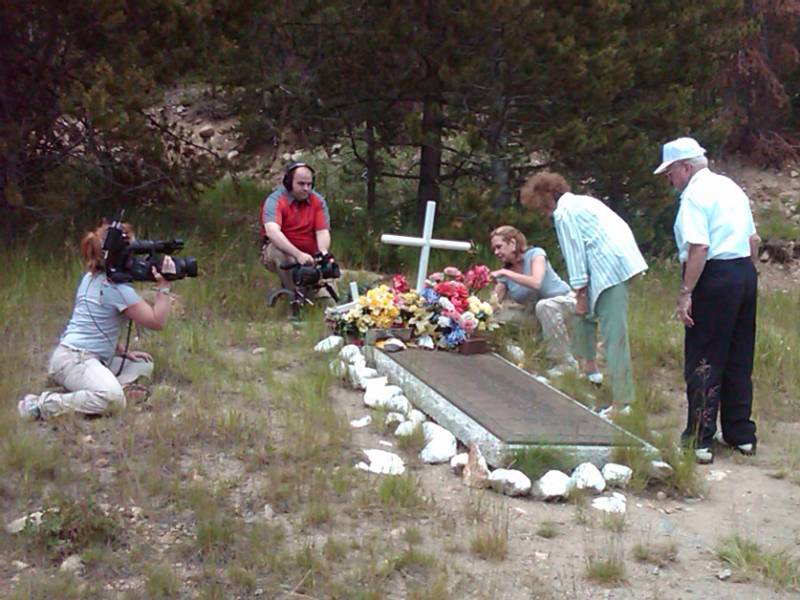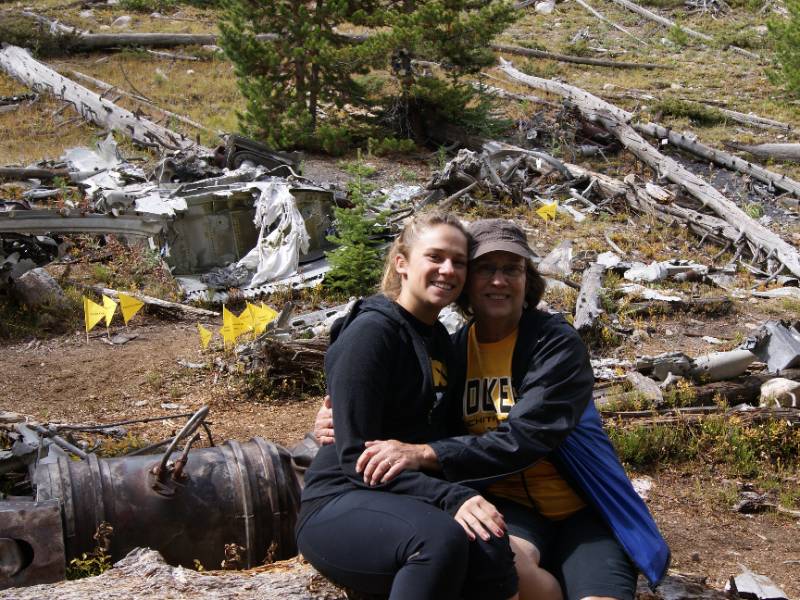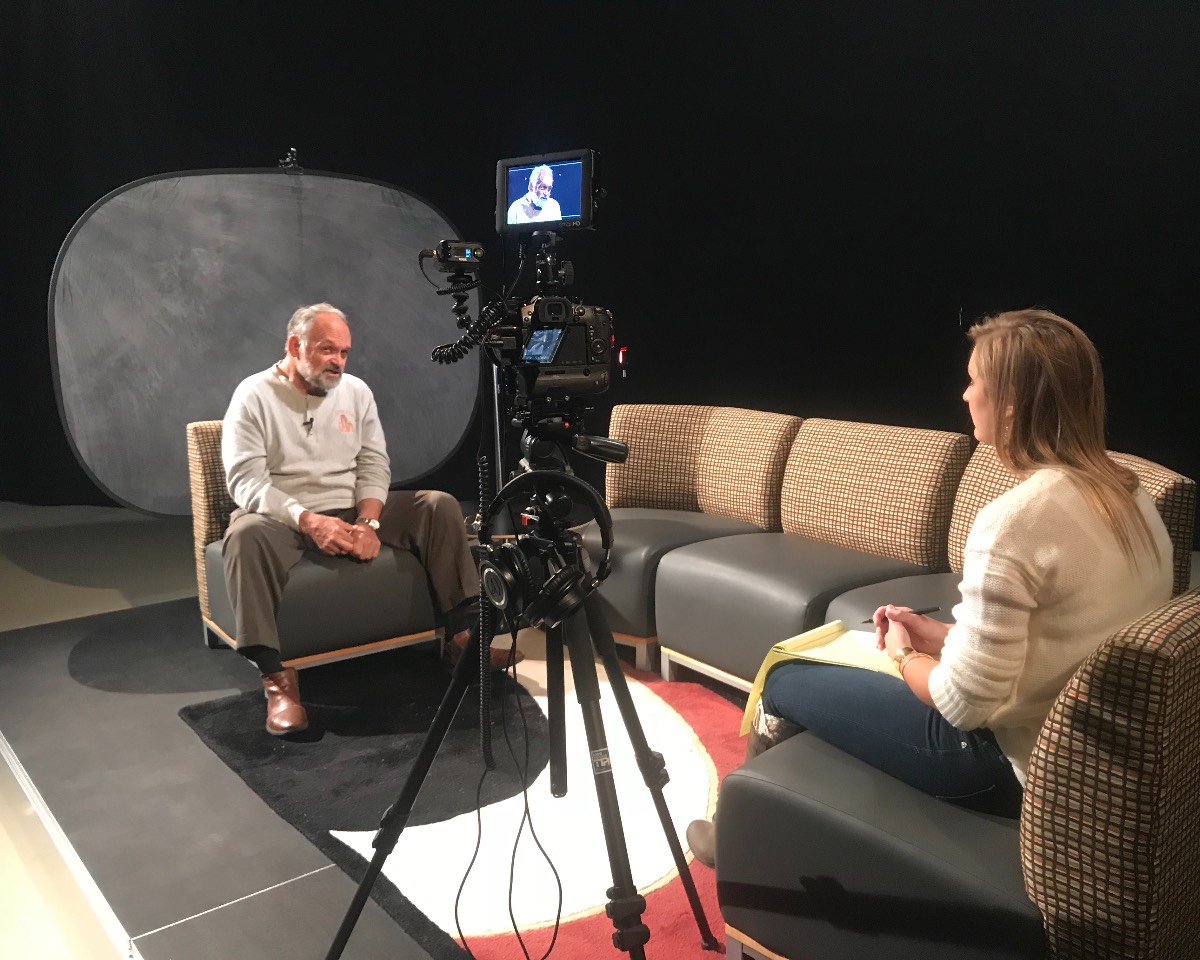 Courtesy art
Courtesy artMike Kennedy remembers when the paper bearing the Associated Press bulletin came over the wire in the KMUW radio newsroom on that October day in 1970.
A plane carrying the Wichita State University football team had crashed. The Associated Press, Kennedy recalls, embargoed the story until reporters learned more details. Early reporting varied between all surviving and none surviving.
Two planes carried the team, but which crashed?
“There was such a sense of shock and disbelief,” he said. “I really think we were some of the first people in Wichita to know about it. We started dividing up assignments. We knew there were two planes. They sent me over to the administration building to see if it was possible to find out which plane it was.”
He walked from the former KMUW building on 17th Street to Morrison Hall.
Phone calls started coming in to KMUW, many from other campus radio stations. Kennedy remembers staff members taking several calls from Ohio, home of several Shocker coaches and football players.
“One thing that always struck me was, walking over, it was about as a beautiful an afternoon as you could ever want,” said Kennedy, a 1971 Wichita State graduate and long-time radio voice of Shockers athletics. “And I understood, it was the same in Colorado.”
As it turned out, the Oct. 2, 1970 plane crash killed 31 people – 14 players, 14 staff, administrators and boosters, the pilot and two flight attendants. Eight players and the co-pilot survived the crash of the Martin 404 on a Friday afternoon on Mount Trelease near Silver Plume, Colorado. The Shockers were flying to Logan, Utah for a game the next day at Utah State.
The initial news coverage focused on the aftermath – Federal Aviation Administration hearings, funerals, lawsuits and the team’s game against Arkansas in Little Rock a few weeks later.
As time passed, journalists, many of them Wichita State students and graduates, documented the stories of the families of the victims, the survivors and their struggles, and their teammates and friends. The stories depended on those memories and a willingness, sometimes a need, to keep the story alive.
Former KWCH-TV sports anchor
“There was a very real part of them that felt it was something that they owed those that perished,” said Bruce Haertl, a former sports anchor at KWCH-TV in Wichita.
A similar sense of responsibility grew within the story-tellers.
Some of them, such as Kennedy and former Wichita Eagle columnist Bob Lutz, lived through the crash and its aftermath. Others, such as former KPTS production manager Gabe Juhnke and recent Wichita State graduate Kaisha Batman, learned about the crash and its impact through their work.
They uniformly regard the stories as some of their best and most important work. Many visited the crash site. They think about the survivors and the victims around October or when they pass Memorial ’70 and are proud to play a role in documenting the stories.
Teammates such as John Yeros, Ed Plopa and John Potts took lead roles in speaking to the media, always with the goal of honoring their teammates. Survivors such as Rick Stephens and Dave Lewis spoke about their ordeal and grief with the same intentions.
“I felt really, really honored to share their story,” said Abigail Beckman, a former reporter for KMUW. “Rick has told this story, I’m sure, hundreds of times and that’s his way of sharing his testimony about the people he cared so much about. I found so many other (stories) as a way to remember it and let these people know that it mattered and it still matters.”
 Courtesy art
Courtesy artAbigail Beckman: Part of family history
Beckman, who earned a masters degree in communications from Wichita State in 2015, wrote and reported “The Pieces That Remain: Remembering the Wichita State Plane Crash” in 2016 for KMUW.
She started her work on the story as a personal matter. Bob Renner, her uncle, is one of the survivors. She wanted to more about the events and how they affected her family. She started the reporting for a class project and later expanded her work for KMUW, including a 2014 hike to the crash site with Stephens, Yeros, her mother (Linda Renner Wilson) and others.
“I didn’t feel like I could understand the impact of the story without being there, and I wanted to bring that to my piece,” Beckman said. “Having Rick back in that spot to talk about it, and the fact he was willing to do that, is something I felt really needed to be appreciated and shared. These men that survived are all getting up in years and I didn’t want that to be lost, for the Wichita State community.”
Bob Lutz: Drawing out stories from the survivors
Lutz, a Wichita State graduate in general studies, worked at The Wichita Eagle from 1974-2017, mostly as a sports writer and columnist. He wrote more about the crash than any other media member, and personal connections led his story-telling.
He was a sophomore at Derby High School in 1970 and knew former Derby football star Steve Moore, one of the victims of the crash.
“I was certainly highly motivated to do my best work, writing about a subject like that and getting to know quite a few of the families of those who did not survive and most of the guys who did survive,” Lutz said. “It was melancholy, but also uplifting to get to know that many people and get to know the human side of a tragic event like that.”
Lutz told the story, in 1995, about Randy Kiesau and his parents’ memories of their son. Lewis had not spoken about the crash to media members, or many people at all, before his 2005 interview with Lutz. In 2016, Lewis wrote an essay for The Eagle titled “This tragedy did not define me.”
In 2010, Lutz went to Nixa, Missouri, to interview the family of crash victim Mal Kimmel. He wrote about survivors such as Stephens, John Hoheisel and Randy Jackson. He spoke to Bob Seaman, elevated from offensive coordinator to head coach at 38 after the crash, for a rare look into the memories of Seaman and his family.
“You walk in on eggshells, that I want to tell your story, and I want you to feel comfortable being able to talk about it,” Lutz said. “I think it helped that I was able to say, genuinely, that I was a fan of that program and I went to a lot of their games and knew that team. I remember walking home from school and being distraught – Derby had a game that night at Campus – and we all went . . . and all we could think about was the crash.”
Bruce Haertl: Humbled by the events
Haertl’s connection to the story started when he arrived at Wichita State in 1978 to play baseball. The tragedy remained fresh among people on campus and the annual memorial ceremony a poignant reminder for the many people who attended or worked at the school eight years earlier.
Haertl did numerous stories during his time as a KWCH sports reporter and anchor from 1984-2012. He felt humbled by the work and the expressions of pain and sadness he heard.
“I wish it had been a cathartic process for those guys, but I always felt their pain,” he said. “The sense of loss never really changed from within them. Being part of a team, being part of a brotherhood. The great memories and friendships you develop with your teammates. That was stripped away.”
Haertl, as part of television duties for Wichita State basketball, took many road trips with the Shockers. He went to Evansville, Indiana, several times with Wichita State and went to Marshall University (in West Virginia) as part of the Kansas State football broadcast. Those universities also endured fatal athletic plane crashes.
“It has changed me in subtle ways,” he said. “The profound sadness we feel as a community at Wichita State in October, no matter where you are. For me, it goes even a little bit further. All of the traveling I did at Wichita State … it is never really far from me when I step on a plane. You cannot fly into those places without thinking of those events.”
Gabe Juhnke: Long-form look at the events
Juhnke, a 2004 graduate who majored in electronic media, served as co-producer for "Black and Gold — Remembering the WSU Plane Crash" in 2009. The hour documentary aired on Public Broadcasting Service station KPTS.
“It became a story about the people and the survivors and the families,” he said. “The story that we told was really a story of resilience.”
Juhnke grew up in Wichita and his parents attended Wichita State. Before work on the documentary, he knew not much more than the basics about the crash. His work, which included a trip to the crash site, helped him understand the crash and its aftermath. When he interviewed teammates, such as Yeros, he drew inspiration from their devotion to remembering their friends and helping each other through the tragedy.
“It made me really proud to be an alumni,” he said. “Hearing the full story and feeling attached to the university in a different way, I felt a different type of pride for what the university has gone through. The brotherhood that I witnessed as a result of talking to a lot of them was really inspiring.”
 Maxwell Frish
Maxwell FrishKaisha Batman and Maxwell Frish: History lesson
Batman, a 2020 graduate who majored in communication, started her work on the plane crash for an Elliott School of Communication class. That research paper, including phone interviews with Plopa and Yeros, led to an interview with Stephens for WSU TV in 2018.
“I was telling some of my friends about the projects I was doing, and they knew absolutely nothing about it,” Batman said. “It was such a monumental thing that happened in our history. It’s just kind of forgotten about. I do feel like it’s something that needs to be remembered in Wichita State’s history. It scares me that, one day, people won’t remember what happened.”
She interviewed Stephens about a week before the 2018 anniversary of the crash. Maxwell Frish, a 2019 Wichita State graduate with a major in media arts and film-making, helped with filming and production of the 9-minute video.
“We wanted to do a story that was anything that was different from what we had read before,” said Batman, who teaches video production at Dodge City High School. “We didn’t see many that were directly through the eyes of one survivor. With Rick, we focused solely on his story and what he went through. We really focused on the moments he knew the plane was going to crash, waking up and what he remembered. It was such a humbling and heart-felt experience. He still would get choked up at moments and he held back tears.”
The interview with Stephens reinforced the need to prepare with research and a list of questions, while being ready to take the conversation in other directions.
“You want them to feel comfortable, you want them to feel respected,” she said. “You weave through the interview where you ask him questions, that you want the answers to, but you also have to be very respectful of what he’s feeling.”
Adam Knapp: Two stories of loss
Knapp, a 1993 Wichita State graduate who majored in communication, remembers fondly a call from Jim Rhatigan, the former Wichita State senior vice president. Rhatigan, who served as dean of students at the time of the crash, complimented Knapp on a story about the crash in the Sunflower.
As a sports reporter at the Eagle, Knapp wrote a 2000 story comparing and contrasting the aftermath of the tragedies at Wichita State and Marshall (also in 1970). Wichita State dropped its football program in 1986, largely due to financial reasons and low attendance. Marshall resumed football after a crash that killed 75 in West Virginia.
“When I look back at my 11 years in The Eagle, I, in a lot of ways, consider that my signature story,” he said. “I don’t know that I’ll ever write anything that will touch me so much as that did. It kind of made me feel like I was part of the family feeling sorrow. I wasn’t only a Shocker beat writer, I was a Shocker alum.”
Knapp, as a student, gave tours for the admissions department. He took groups by Cessna Stadium and remembers answering questions about football.
“Someone would always ask about the crash,” he said. “So much time has gone by now, I think there’s a real misconception that that’s the day we lost football. It’s hard for that anniversary to pass now and me not to feel something. It’s like a grandpa you never met.”

